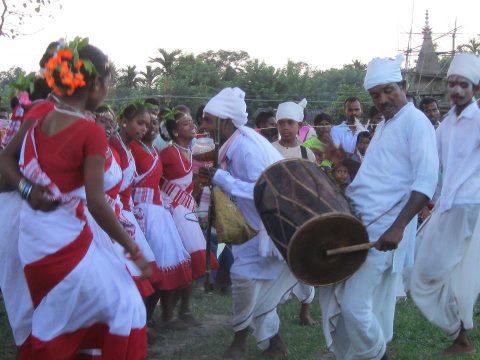Jhumur is a traditional dance of the tea tribal communities of Assam and also in some parts of West Bengal. It is usually performed in the harvest season and festivals. The main performers of the act are girls, but the music, vocals, and instruments for the performance are maintained by the male performers.

Festivals of Tea Tribes
Jhumur dance is mainly performed on festivals like Karam puja and Tushu puja. Karam puja is one of the most important festivals for the tea tribes. It is a week-long celebration to worship Karam Raja. For an entire week, songs are sung, dances are danced, and people stay up late at night to celebrate and worship.
The final day of the week is commemorated by the cleaning and decorating of the houses to welcome the god. And the young girls of the households then perform the Jhumur dance in celebration of god’s arrival.
Jhumur Dance Performance
The main act of the dance is performed by the girls. They gather in groups and hold each other side by side by their waists and move their legs and body forward and backward in a swaying motion. The dance is extremely synchronized and appears charming to the eye.
The music and the songs of the performance are managed by the male performers. The songs of Jhumur sing depict the love of pleasures and pain of day-to-day life. And the songs are composed in the regional language and therefore have a homely feeling embedded in them.
Jhumur Dance Costumes
The attires for the Jhumur dance are very versatile. The attires of the performers change in accordance with the region and the occasion. The female performers usually drape a white saree with red borders, and the male performers wear long kurta like a traditional dress.
Musical Instruments
The musical instruments used in Jhumur dance are Madal, Dhol, Flute, Shehnai, Bansi (Flute), Dhak, and a pair of Taal.

Pingback: All Folk Dances of India - Auchitya
Pingback: All Folk Dances of India - Auchitya